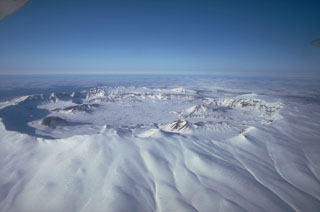Report on Okmok (United States) — 30 July-5 August 2008
Smithsonian Institution / US Geological Survey
Weekly Volcanic Activity Report, 30 July-5 August 2008
Managing Editor: Sally Sennert.
Please cite this report as:
Global Volcanism Program, 2008. Report on Okmok (United States) (Sennert, S, ed.). Weekly Volcanic Activity Report, 30 July-5 August 2008. Smithsonian Institution and US Geological Survey.
Okmok
United States
53.43°N, 168.13°W; summit elev. 1073 m
All times are local (unless otherwise noted)
Based on observations of satellite imagery and pilot reports, AVO reported that ash plumes from Okmok rose to altitudes of 4.6-10.7 km (15,000-35,000 ft) a.s.l. and drifted SW, W, N, NNE, and SE. On 30 July, seismicity alternated between continuous and pulsating volcanic tremor. The Volcano Alert Level was lowered to Watch and the Aviation Color Code was lowered to Orange. On 31 July, reports from a fishing boat 11.3 km N indicated no visibility due to ashfall.
Strong volcanic tremor on 2 August prompted AVO to raise the Volcano Alert Level to Warning and the Aviation Color Code to Red. Cloudy conditions prevented satellite observations. Later that day, AVO geologists in the area reported that ash-and-steam plumes rose to minimum altitude of 6.1 km (20,000 ft) a.s.l. The seismicity decreased and the Volcano Alert Level was lowered to Watch and the Aviation Color Code was lowered to Orange. Observers in Ft. Glenn on Umnak Island reported smelling sulfur and seeing a larger ash plume than earlier that day. The plume drifted ESE. On 3 August, helicopter and ground-based observers indicated a lower-altitude ash plume along with a higher steam plume. Satellite imagery revealed that ash plumes at altitudes of 9.1-10.7 km (30,000-35,000 ft) a.s.l. drifted SSW. On 4 August, ashfall reported in Nikolski had accumulated to a depth of 3 mm. During 4-5 August satellite imagery and pilot observations indicated that ash plumes rose to altitudes of 3-7.6 km (10,000-25,000 ft) a.s.l. and drifted SW and W.
Geological Summary. The basaltic Okmok shield volcano forms the NE end of Umnak Island in the Aleutian Islands. The summit of the low, 35-km-wide volcano is cut by two overlapping 10-km-wide calderas formed during eruptions about 12,000 and 2,050 years ago when dacitic pyroclastic flows reached the coast. More than 60 tephra layers from Okmok have been found overlying the 12,000-year-old caldera-forming tephra layer. Numerous cones and lava domes are present on the flanks down to the coast, including the SE-flank Mount Tulik, which is almost 200 m higher than the caldera rim. Some of the post-caldera cones show evidence of wave-cut lake terraces; more recent cones were formed after the caldera lake, once 150 m deep, disappeared. Eruptions have been reported since 1805 from cinder cones within the caldera, where there are also hot springs and fumaroles.
Source: US Geological Survey Alaska Volcano Observatory (AVO)

